
Paros is a Greek island in the central Aegean Sea. Part of the Cyclades island group, it lies to the west of Naxos, from which it is separated by a channel about 8 kilometres wide. It lies approximately 150 km south-east of Piraeus. The Municipality of Paros includes numerous uninhabited offshore islets totaling 196.308 square kilometres (75.795 sq mi) of land. Its nearest neighbor is the municipality of Antiparos, which lies to its southwest. In ancient Greece, the city-state of Paros was located on the island.

Souvlaki is a Greek fast food consisting of small pieces of meat and sometimes vegetables grilled on a skewer. It is usually eaten straight off the skewer while still hot. It can be served with or inside a rolled pita, typically with lemon, sauces, vegetables such as sliced tomato and onion, and fried potatoes as a side. The meat usually used in Greece and Cyprus is pork, although chicken, beef, and lamb is used in Turkish kitchens.
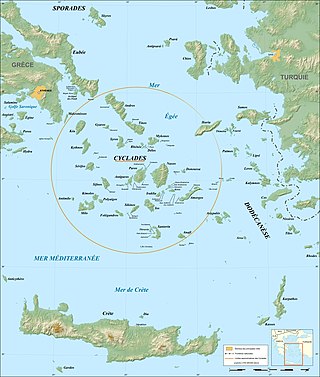
Cycladic culture was a Bronze Age culture found throughout the islands of the Cyclades in the Aegean Sea. In chronological terms, it is a relative dating system for artifacts which serves as a roughly contemporary dating system to Helladic chronology and Minoan chronology (Crete) during the same period of time.

Antiparos (Greek: Αντίπαρος; Ancient Greek: Ὠλίαρος, romanized: Oliaros; Latin: Oliarus; is a small island in the southern Aegean, at the heart of the Cyclades, which is less than one nautical mile from Paros, the port to which it is connected with a local ferry. Saliagos island is the most ancient settlement in the Cyclades, and Despotiko, an uninhabited island in the southwest of Antiparos, is a place of great archaeological importance.
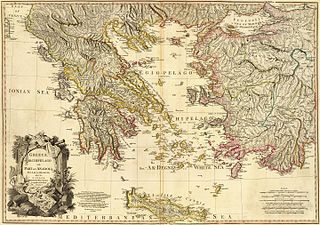
Helladic chronology is a relative dating system used in archaeology and art history. It complements the Minoan chronology scheme devised by Sir Arthur Evans for the categorisation of Bronze Age artefacts from the Minoan civilization within a historical framework. Whereas Minoan chronology is specific to Crete, the cultural and geographical scope of Helladic chronology is confined to mainland Greece during the same timespan. Similarly, a Cycladic chronology system is used for artifacts found in the Aegean islands. Archaeological evidence has shown that, broadly, civilisation developed concurrently across the whole region and so the three schemes complement each other chronologically. They are grouped together as "Aegean" in terms such as Aegean art and, rather more controversially, Aegean civilization.

Frying pans is the descriptive nickname for a type of Early Cycladic II artifacts from the Aegean Islands around 2700-2200 BCE. They are flat circular disks with a "handle", and usually made from earthenware, but sometimes stone. They are found especially during the Cycladic Grotta-Pelos and Keros-Syros cultures. Their purpose remains unknown, although they are usually interpreted as prestige goods.
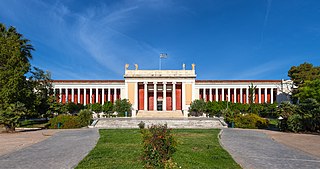
The National Archaeological Museum in Athens houses some of the most important artifacts from a variety of archaeological locations around Greece from prehistory to late antiquity. It is considered one of the greatest museums in the world and contains the richest collection of Greek Antiquity artifacts worldwide. It is situated in the Exarcheia area in central Athens between Epirus Street, Bouboulinas Street and Tositsas Street while its entrance is on the Patission Street adjacent to the historical building of the Athens Polytechnic university.

Minoan pottery has been used as a tool for dating the mute Minoan civilization. Its restless sequence of quirky maturing artistic styles reveals something of Minoan patrons' pleasure in novelty while they assist archaeologists in assigning relative dates to the strata of their sites. Pots that contained oils and ointments, exported from 18th century BC Crete, have been found at sites through the Aegean islands and mainland Greece, in Cyprus, along coastal Syria and in Egypt, showing the wide trading contacts of the Minoans.

Keros is an uninhabited and unpopulated Greek island in the Cyclades about 10 km (6 mi) southeast of Naxos. Administratively it is part of the community of Koufonisia. It has an area of 15 km2 (6 sq mi) and its highest point is 432 m (1,417 ft). It was an important site to the Cycladic civilization that flourished around 2500 BC. It is now forbidden to land in Keros.

Despotikó, anciently, Prepesinthus or Prepesinthos, is a small, uninhabited Greek island in the Cyclades. It is situated west of the island of Antiparos, and east of the smaller island of Strongyli.

The ancient Cycladic culture flourished in the islands of the Aegean Sea from c. 3300 to 1100 BCE. Along with the Minoan civilization and Mycenaean Greece, the Cycladic people are counted among the three major Aegean cultures. Cycladic art therefore comprises one of the three main branches of Aegean art.
A frying pan is a pan used for cooking, also known as a skillet. Frying pan may also refer to:
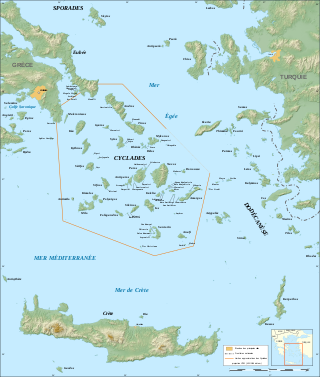
The Cyclades are Greek islands located in the southern part of the Aegean Sea. The archipelago contains some 2,200 islands, islets and rocks; just 33 islands are inhabited. For the ancients, they formed a circle around the sacred island of Delos, hence the name of the archipelago. The best-known are, from north to south and from east to west: Andros, Tinos, Mykonos, Naxos, Amorgos, Syros, Paros and Antiparos, Ios, Santorini, Anafi, Kea, Kythnos, Serifos, Sifnos, Folegandros and Sikinos, Milos and Kimolos; to these can be added the little Cyclades: Irakleia, Schoinoussa, Koufonisi, Keros and Donoussa, as well as Makronisos between Kea and Attica, Gyaros, which lies before Andros, and Polyaigos to the east of Kimolos and Thirassia, before Santorini. At times they were also called by the generic name of Archipelago.

The Wandsworth Shield is a circular bronze Iron Age shield boss or mount decorated in La Tène style which was found in the River Thames at Wandsworth in London sometime before 1849. Another incomplete bronze shield mount, sometimes called the Wandsworth Mask Shield was found at the same time. Both shield mounts are now held at the British Museum. The bold repoussé decoration on the Wandsworth Shield, comprising two birds with outstretched wings and long trailing tail feathers, has led Barry Cunliffe, Emeritus Professor of European Archaeology at the University of Oxford, to consider the shield to be "among the masterpieces of British Celtic art".
The Cycladic frying pan is a ceramic item from the Bronze Age Cycladic civilization. It dates to the early Cycladic period, between the 28th and 23 centuries BC. The frying pan derives from grave 74 of Chalandriani cemetery on the Cycladian island of Syros. It was discovered in 1889/90 during excavations led by Christos Tsountas, along with other pottery and was first published by Tsountas in 1899. With the inventory number 4974, the frying pan is now kept in the National Archaeological Museum of Athens. The purpose of the frying pan is unknown.
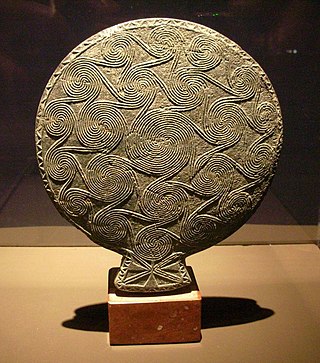
The Cycladian frying pan is an ornately decorated stone object of the type nicknamed as frying pans, from the Bronze Age Cycladic civilization. It dates to the Early Cycladic period, between the 27th and 24th centuries BC. The find spot is unknown, except that it originated on the Cycladic island of Naxos. The item derived from an illegal excavation and was acquired in 1975 by the Baden State Museum in Karlsruhe. On 6 June 2014 it was repatriated to the National Archaeological Museum of Athens, Greece.
The Spool-shaped pxis is a ceramic vessel from the Bronze Age Cycladic civilisation. The "dark on light" painted pyxis was found in grave 271 of the necropolis at Chalandriani on the Cycladic island of Syros and dates to the early Cycladic period. It was discovered in 1889/90 during excavations led by Christos Tsountas and as first published by Tsountas in 1899. It is displayed in the National Archaeological Museum, Athens with the inventory number 5225.
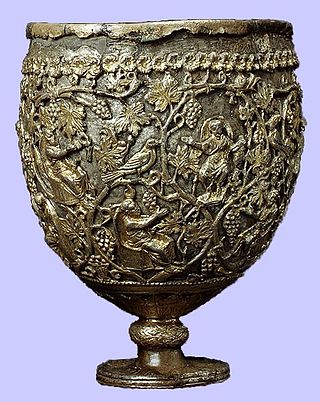
Silver was important in Byzantine art and society more broadly as it was the most precious metal right after gold. Byzantine silver was prized in official, religious, and domestic realms. Aristocratic homes had silver dining ware, and in churches silver was used for crosses, liturgical vessels such as the patens and chalices required for every Eucharist. The imperial offices periodically issued silver coinage and regulated the use of silver through control stamps. About 1,500 silver plates and crosses survive from the Byzantine era.

Saliagos is an islet in the Greek island group of Cyclades. It is the first early farming site and one of the oldest settlements of the Cycladic culture.

In Thee Rejoiceth also known as Epi Si Harri is a tempera and gold leaf painting by Theodore Poulakis. The central figure of the piece is the Virgin Mary. The painting is a tribute to her. Poulakis was from Chania Crete. He was active on the Ionian islands and in Venice during the second half of the 17th century. He was a member of the Cretan School and the father of the Heptanese School. According to the Institute of Neohellenic Research, 130 paintings are attributed to Poulakis.



















